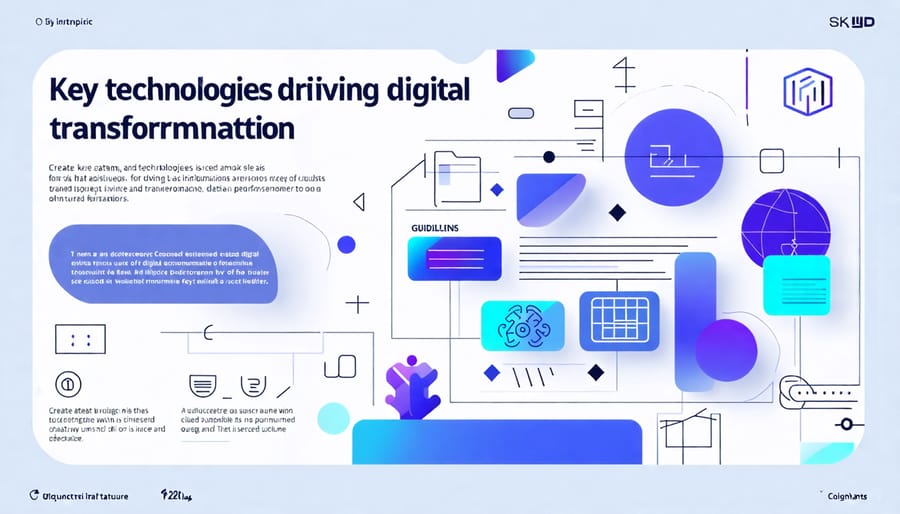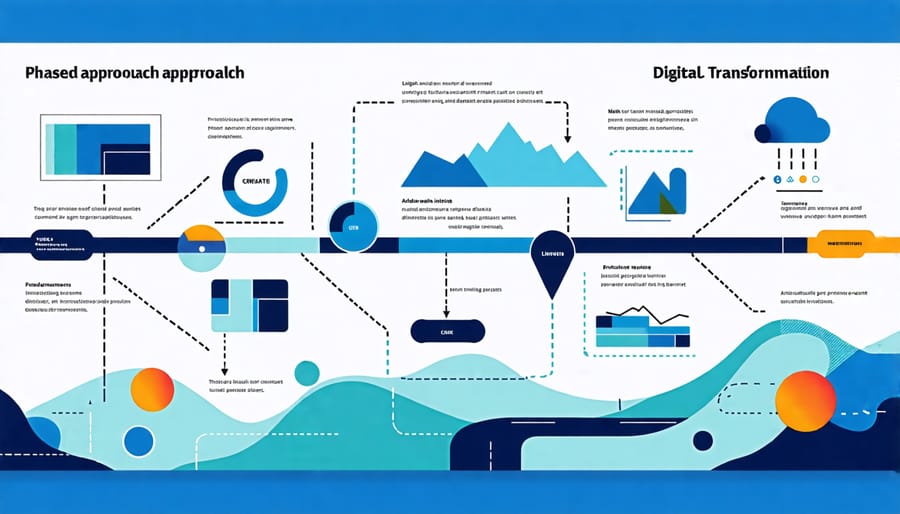Transform your small business into a digital powerhouse by implementing these digital strategies to skyrocket your business:
1. Leverage cloud-based tools to streamline operations, enhance collaboration, and drive productivity.
2. Optimize your website for mobile devices to capture the growing number of consumers browsing and purchasing via smartphones.
3. Harness the power of data analytics to gain valuable insights into customer behavior, market trends, and business performance.
4. Embrace automation technologies to reduce manual tasks, minimize errors, and free up resources for high-value activities.
Understanding Digital Transformation

Key Technologies Driving Change
Several essential technologies are powering digital transformation for small businesses. Cloud computing enables companies to access powerful software, storage, and computing resources on-demand, reducing IT costs and increasing flexibility. Mobile technologies allow businesses to operate, collaborate and engage customers from anywhere. Artificial intelligence and machine learning help automate processes, gain insights from data, and enhance decision-making. Business process automation streamlines repetitive tasks, improves efficiency and frees up staff to focus on higher-value work. By strategically adopting these key technologies, Canadian small businesses can become more agile, data-driven and customer-centric, ultimately driving growth in the digital age. While the array of options may seem daunting, getting started with small pilot projects and iterating over time can make digital transformation manageable and impactful for businesses of any size.

Shifting Consumer Expectations
The digital age has fundamentally reshaped consumer behaviors and expectations. Today’s customers expect seamless, personalized experiences across all touchpoints, whether they’re browsing a website, making an online purchase, or seeking customer support. They demand the convenience of digital self-service options, the ability to engage with businesses through their preferred channels, and rapid response times.
For small businesses, meeting these expectations is no longer optional – it’s a matter of survival. Customers are increasingly likely to choose companies that offer digital capabilities over those that don’t. Failing to adapt risks losing business to more digitally-savvy competitors.
But digital transformation isn’t just about keeping up; it’s also an opportunity to exceed customer expectations and foster greater loyalty. By leveraging digital tools and data, small businesses can gain deeper insights into their customers’ needs and preferences, enabling them to deliver more targeted, value-added experiences. In short, embracing digital is key to remaining competitive and relevant in the eyes of today’s consumers.
Benefits of Going Digital
Improved Customer Experience
In today’s digital age, customers expect seamless, personalized experiences from the businesses they interact with. By leveraging digital tools, small businesses can elevate their customer experience and foster greater satisfaction and loyalty. For example, implementing a customer relationship management (CRM) system allows you to centralize customer data, track interactions, and gain valuable insights into their preferences and behaviors. This enables you to deliver targeted communications, personalized recommendations, and proactive support that resonates with each individual customer.
Additionally, digital platforms like social media and live chat provide opportunities for real-time engagement, allowing you to promptly address inquiries, resolve issues, and build stronger relationships with your audience. By investing in user-friendly websites, intuitive mobile apps, and streamlined e-commerce solutions, you can offer customers the convenience and flexibility they crave, making it easier for them to engage with your brand and make purchases on their own terms.
Operational Efficiency
Digital transformation can significantly boost operational efficiency for small businesses. By digitizing processes, you can reduce time-consuming manual tasks and paperwork. For instance, invoicing software automates billing, minimizes errors, and speeds up payment collection. Digital inventory management provides real-time visibility, reducing stockouts and overstocking. Customer relationship management (CRM) systems centralize data, enabling personalized service and targeted marketing. Canadian entrepreneur Sarah streamlined her boutique’s operations with a POS system integrated with inventory and accounting software, saving hours weekly. Embracing digital tools also generates valuable data for optimization. Analytics reveal insights into sales trends, customer behaviour, and process bottlenecks. Data-driven decisions improve resource allocation, staffing, and pricing. Cloud-based collaboration platforms keep remote teams connected and productive. Ultimately, digitization allows small businesses to operate more efficiently, adapt quickly, and compete effectively in today’s fast-paced market.
Competitive Advantage
By leveraging digital capabilities, small businesses can differentiate themselves from competitors and unlock new opportunities for growth. Digital tools enable SMBs to reach broader markets, both domestically and internationally, expanding their potential customer base. For example, a local artisan can sell their handcrafted goods globally through an e-commerce website or online marketplaces like Etsy. Additionally, digital capabilities allow small businesses to diversify their revenue streams by offering digital products or services alongside traditional offerings. A yoga studio could create online courses or virtual classes to complement in-person sessions, appealing to customers who prefer remote options. By embracing digital transformation, small businesses position themselves to explore profitable business ideas and stay competitive in an increasingly digital world.

A Phased Approach to Transformation
Assess Your Current State
To assess your current digital state, start by evaluating your company’s technology usage and capabilities. Consider areas such as your website, e-commerce presence, digital marketing, data analytics, and internal processes. Identify any manual, time-consuming tasks that could be automated or streamlined with digital tools. Examine how well you’re leveraging digital channels to engage with customers and drive sales. Look for gaps in your digital strategy and opportunities to enhance efficiency, reach, and competitiveness. Conducting a thorough assessment will provide a clear picture of your digital maturity and help prioritize areas for improvement as you embark on your digital transformation journey.
Develop a Roadmap
To prioritize your digital transformation initiatives, start by identifying the areas that will have the biggest impact on your business goals. Consider factors like customer experience, operational efficiency, and revenue growth potential. Once you’ve identified these key areas, break them down into specific projects and rank them based on urgency, feasibility, and expected ROI.
Next, develop a realistic timeline for each initiative, taking into account your resources, budget, and team capacity. Be sure to include milestones and checkpoints to track progress and make adjustments as needed. Remember, digital transformation is an ongoing journey, not a one-time event.
As you craft your roadmap, keep your team and stakeholders engaged by communicating the vision, goals, and benefits of each initiative. Provide training and support to help employees adapt to new tools and processes. Celebrate successes along the way and learn from any setbacks.
By aligning your digital transformation roadmap with your overall business strategy, you’ll be well on your way to launching a thriving business in the digital age.
Build Capabilities Iteratively
Building digital capabilities doesn’t have to be an overwhelming undertaking. By adopting an agile, iterative approach, small businesses can gradually develop the necessary skills and tools without overextending their resources. Start by identifying the most critical areas for digital transformation, such as customer engagement, e-commerce, or data analytics. Break down the implementation into manageable stages, setting achievable goals and milestones along the way. As you progress, assess your team’s training needs and consider hiring specialists to fill skill gaps. Encourage continuous learning and experimentation, empowering employees to adapt to new technologies and processes. Celebrate small victories and learn from setbacks, using each iteration to refine your digital strategy. Remember, digital transformation is an ongoing journey, not a one-time event. By taking an incremental approach, small businesses can steadily enhance their digital capabilities while minimizing risk and disruption to their core operations.
Conclusion
Digital transformation is no longer optional for small businesses – it’s a necessity to remain competitive in today’s rapidly evolving marketplace. By embracing digital tools and strategies, you can streamline operations, enhance customer experiences, and unlock new growth opportunities. The journey may seem daunting, but with a clear vision, a step-by-step plan, and the right mindset, any small business can successfully navigate the digital landscape.
Remember, digital transformation is not a one-time event but an ongoing process of continuous improvement. Start small, celebrate quick wins, and build momentum as you go. Engage your team, seek out learning opportunities, and don’t be afraid to experiment with new ideas. Every small step forward brings you closer to a more agile, resilient, and future-ready business.
As a Canadian small business owner, you have access to a wealth of resources and support to help you on your digital journey. Take advantage of government programs, industry associations, and local business communities to connect with peers, learn best practices, and find the tools and expertise you need to succeed.
The time to act is now. Embrace the power of digital transformation and position your small business for long-term success in the digital age. With dedication, adaptability, and a customer-centric approach, you can create a thriving, sustainable business that stands the test of time. Start your digital transformation today and unlock a world of possibilities for your small business.
You may also like
-
Why Brazilian Betting Platforms Want to Partner with Your Canadian Business
-
Revamp Your Small Business: Digital Transformation Success in Canada
-
Transform Your Small Business with Must-Have Automation Tools
-
Boost Your Small Business with Google Analytics: A Step-by-Step Approach
-
Boost Team Spirit Fast: 5-Minute Activities for Busy Small Groups

